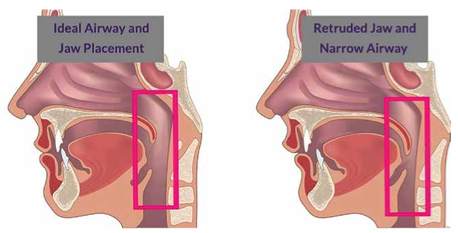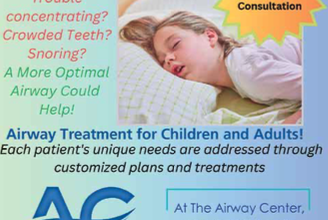Dr. Nathan Tanner Airway Center – Breathe Easy
At the Airway Center, Dr. Tanner and his team are revolutionizing the way we think about dental health and its connection to overall wellness. The Airway Center focuses on the correlation between jaw development and airway health, specifically addressing how orthodontic treatments can impact this critical relationship. By advancing protractive treatments, Dr. Tanner’s approach helps patients avoid issues like sleep apnea, TMJ, and other health problems related to impaired breathing due to smaller jaw structures. With a mission to raise public awareness about the importance of proper jaw development, Dr. Tanner is a leading voice in the intersection of orthodontics and airway health.
Hi Dr. Tanner, thanks for taking the time to speak with us today and welcome to LocalsGuide.
Thank you! I’m thrilled to connect with our community and discuss the vital role of airway health. Understanding airway issues and their impact on sleep can transform lives. We’re eager to offer valuable insights to your audience and collaborate in serving the community.
Dr. Tanner to begin with, can you please explain the connection between jaw development and airway health? How does improper jaw growth impact breathing?
Certainly, the connection between jaw development and airway health is quite profound. Historically, our ancestors had more forward-developed jaws, which provided ample space for easy breathing. Nowadays, many children experience crowded teeth at a younger age than their parents did, leading to most people being referred to an orthodontist as a child.
When the jaws don’t develop properly, it can push the tongue back into the throat, reducing space for airflow. This restricted airway can often lead to issues like restless sleep, asthma, allergies, and mouth breathing for both children and adults.
By promoting proper forward jaw development and giving adequate tongue space we can greatly enhance a patient’s health and vitality. Not only does this lead to a wider, more aesthetically pleasing smile and a strong jawline, but it also improves oxygenation throughout the body, which boosts overall wellbeing.
Traditional orthodontic methods may restrict jaw growth. What are some of these common techniques, and why might they not be the best approach?
Traditional orthodontic methods, such as palatal expansion, extraction of permanent teeth, headgear, and class 2 elastics primarily focus on aligning teeth for a straight smile and esthetically pleasing bite. While these techniques aim to correct dental alignment, they may miss essential aspects of jaw development and overall health.
Palatal expansion, which widens the upper jaw, is more favorable than tooth extraction, however, it doesn’t fully address the forward growth for optimal breathing and sleeping. This forward development is crucial for creating a harmonious, comfortable, and functional bite.
When we focus on forward jaw development, the benefits extend beyond dental alignment.
While traditional methods aim for alignment and they do that well, prioritizing forward jaw development provides comprehensive benefits that can significantly improve both breathing and sleep quality alongside creating a balanced and functional bite.
You’ve mentioned that smaller mouths and teeth extraction techniques can contribute to airway problems like sleep apnea. Can you elaborate on this correlation?
Absolutely, there is a correlation between smaller mouths, teeth extraction, and airway issues such as sleep apnea. A smaller mouth can lead to restricted airflow and disrupted sleep patterns, as there often isn’t enough space for the tongue, causing it to fall back into the airway.
Traditional orthodontic methods that involve extracting teeth, tend to align the remaining teeth without developing the jaws forward. This retraction reduces the upper palate’s space, often resulting in a retracted upper jaw and downward growth, which may manifest as gummy smiles and inset jaws. Even if the jaw is widened, retracted front teeth can trap the lower jaw behind the upper jaw, restricting its forward growth or movement and impacting the airway space.
By emphasizing forward jaw development, we can effectively minimize airway constriction and the sleep issues that may arise from the retraction approach.
In your experience, how can fully developing the jaws mitigate issues like sleep apnea and TMJ disorders?
Fully developing the jaws can play a crucial role in mitigating issues like sleep apnea and TMJ disorders. Many individuals tend to rest their tongue between their teeth during the day, which helps to keep the tongue forward for better breathing. However, at night when muscles relax, the tongue often falls back, potentially restricting airflow and causing sleep-disordered breathing or sleep apnea depending on the duration and severity of oxygen-related events.
By focusing on forward jaw development to open the airway, we can alleviate these disruptions and reduce the risk of sleep apnea later in life. Moving the jaws forward creates more space for teeth, including the wisdom teeth, and ensures the back of the tongue has more space, allowing for easier breathing and improved sleep quality. Additionally, by relieving compression on the TMJ, we provide space for healthy jaw function, which can alleviate or prevent symptoms associated with TMJ dysfunction such as facial pain, headaches, jaw soreness, and clicking or locking of the joint.
Can you please share some recent success stories with us?
Absolutely, a mother sought help for her son’s restless sleep, doubting jaw development issues due to no crowded teeth. After two years of searching other healthcare providers, she returned to us. We placed her son on a sleep monitor, linking his sleep issues to breathing problems.
With treatment, his disruptions dropped from 14 per hour to just one, leading to peaceful sleep and improved well-being.
Another patient arrived at our office exhibiting 12 signs of sleep-disordered breathing, though not diagnosed with sleep apnea. He faced persistent poor sleep, asthma, low energy, and frequent illnesses. His mother revealed he had visited the ER nine times in one year, five visits being related to asthma and breathing. After beginning our treatment, his asthma has significantly improved, and his oxygen levels stabilized. His mother is thrilled with the improvements in his sleep and energy levels, reassured that she’s addressing the root cause and fostering a healthy foundation for her child. With her son feeling more vibrant and energetic, their lives have transformed for the better.
Please introduce us to the Airway Center clinic.
At the Airway Center clinic, we have integrated airway health into our general dental practice. Currently, we’re in the process of establishing a dedicated Airway Center location just across the parking lot, where our primary focus will be on airway health through protractive and expansive orthodontics and oral appliances.
Our clinic in Southern Oregon is proud to have attracted patients from 14 states and 4 countries, a testament to our expertise and success in this field. To further expand our impact and raise awareness, we are educating pediatric dentists, orthodontists, and general dentists across the country on methods that enhance airway space and improve breathing. Our vision is to establish Airway Center locations nationwide, employing our holistic orthodontic techniques to transform the future of patients around the world.
What methods do you use to promote natural jaw growth, and how are they different from conventional orthodontic treatments?
Our approach to promoting natural jaw growth is centered around the use of the Tanner Airway Appliance, which encourages the upper jaw to develop three-dimensionally, aligning with the direction of natural growth. In biology we learn that form follows function, so we stimulate a change in shape of the lower jaw to develop it permanently forward.
In contrast to conventional orthodontic methods, which often rely on lateral palatal expansion or widening, our approach mirrors natural physiological growth. Traditional techniques focus on aligning the jaw for aesthetic purposes, ensuring the smile and bite appear pleasing. However, this can result in an uncomfortable bite, reduced palate size, limited airway space, and tired facial muscles as the body struggles to find a functional position. By customizing each appliance to the patient’s unique facial structure and growth potential, we achieve harmony and balance, promoting effective function of the facial muscles, structure, and body as a whole.
What role does early intervention in orthodontics play in supporting airway health and is it ever too late to start?
Starting orthodontic treatment as early as age two is pivotal for supporting airway health. Early intervention addresses space limitations for permanent teeth, fostering optimal jaw and facial development. This proactive measure not only prevents crowding but also enhances the palate space for the tongue, promoting correct tongue posture and ensuring adequate oxygen flow throughout the night. Without intervention, these issues can lead to improper movement of permanent teeth and the development of habits that alter oral facial structures, potentially resulting in a range of sleep-related health and behavioral challenges.
When left unchecked, these habits can evolve into complex orthodontic, oral, and health concerns over time. Thus, early detection and treatment provide a substantial advantage, laying the groundwork for not only proper dental alignment but also improved airway health.
We treat patients from all age groups, including individuals in their 70s, with healthy teeth and gums.
At what age should parents start thinking about jaw development for their children?
Parents should start considering their child’s jaw development as early as age two. Signs such as restless sleep, frequent illness, or consistent tiredness and crankiness in toddlers can indicate underdeveloped jaws, potentially benefiting from improved airflow for better breathing and sleep. Early consultation can be beneficial in these cases.
Even if your child isn’t showing symptoms of poor sleep, it’s important to be observant.
Look for indicators like no space between baby teeth, teeth grinding or clenching, and open mouth posture. An evaluation is advisable if these signs are present.
Can you tell us more about the historical perspective? You’ve said that over 100 years ago, people didn’t have crowded teeth or impacted wisdom teeth. What has changed in our modern environment?
Over a century ago, people rarely faced issues like crowded teeth or impacted wisdom teeth because their natural habits and environments were quite different from ours today. The shift in our modern lifestyle, predominantly due to the introduction of processed foods, has significantly impacted jaw development. Historically, our ancestors consumed harder foods that required more chewing, naturally encouraging proper jaw growth. Now, the ease of soft, processed foods, coupled with increased sugar intake and a lack of essential minerals in our diets, has resulted in smaller jaw sizes over generations.
You’ve mentioned that many of your adult sleep apnea patients had teeth removed as teenagers. How common is this practice, and what impact does it have on long-term health?
In my experience treating hundreds of patients, I’ve observed a significant correlation between the removal of premolar teeth during adolescence and an increased risk of sleep-related issues later in life. While some orthodontists are now shifting away from extractions in favor of newer techniques like Interproximal Reduction (IPR) or palatal expanders to create space, extractions remain a common practice, particularly in cases of severe crowding.
An illustrative example involves a teenager who was presented with a choice between removing permanent teeth or using headgear. Opting for headgear, she developed symptoms such as snoring, restless sleep, mouth breathing, and tinnitus over the two years of treatment. After completing her orthodontic treatment, she began a new therapeutic approach with us. Remarkably, within a year, she reported a resolution of all these symptoms.
What specific signs should parents or patients look for that might indicate improper jaw development or an airway issue?
Parents should be on the lookout for signs such as mouth breathing, frequent awakening at night due to nightmares, sleepwalking, or bedwetting, as these can signal poor sleep quality stemming from airway issues. Emotional difficulties in children may also be a red flag for inadequate rest and should prompt further investigation.
For adults, indicators of potential jaw development or airway concerns include poor sleep, waking up feeling unrefreshed, a compromised immune system, frequent headaches, snoring, and waking up at night to use the bathroom. Each of these symptoms could be linked to airway restrictions that are often significantly alleviated with appropriate treatment.
Recognizing these signs early and seeking expert consultation can make a remarkable difference in improving overall health and well-being.
Once a patient’s airway has been
improved, what can change?
Improving a patient’s airway can profoundly enhance their quality of life. Patients often experience better sleep, waking up refreshed and frequently recalling their dreams. For children, these improvements manifest as enhanced behavior and concentration, often noticed by teachers and caregivers, along with a more positive and stable mood. Additionally, children who frequently suffer from illnesses and respiratory issues tend to fall sick less often and recover more quickly. Adults generally notice increased mental clarity, renewed energy, and a general sense of improved health and wellness.
You mentioned that the ADHD-like behavior in some children can disappear once airway issues are addressed. Can you tell us more about this connection?
The connection between sleep quality and child behavior is quite compelling. Research from the NIH indicates that when children don’t get adequate sleep, often due to airway problems, they tend to exhibit signs of hyperactivity and inattention. It’s similar to how adults might feel a bit frazzled without a good night’s rest, but in children, it often appears as restless or impulsive behavior.
When their airway issues are resolved, and they start receiving optimal deep sleep cycles, we see significant behavioral changes. Parents often report that their children become calmer, more focused, and better at paying attention. It can transform their daily lives, allowing them to develop healthier emotional and behavioral patterns.
What does a typical treatment at the Airway Center look like, and how long does it generally take to see results?
At the Airway Center, a typical treatment plan often involves the use of a removable Tanner Airway Appliance, which is worn 20-22 hours a day for about 6 to 12 months. This device is designed to address and improve airway issues by gradually guiding the jaws and creating more space for proper airflow.
For older children and adults, the treatment might also include the use of aligners or braces. These are intended to straighten and align the teeth while keeping the forward development. In many cases of younger patients, the Tanner Airway Appliance creates sufficient space, allowing a child’s teeth to naturally come into better alignment. If further alignment is needed, it usually requires a relatively brief period of braces to achieve the final adjustments.
Patients often begin noticing improvements within the first six months of treatment or sooner
How can our readers go about learning more about what you have to offer?
To discover more about our treatments and how we can enhance the quality of life for you or your loved ones, visit our website at www.airwaycenter.com or check out our YouTube channel. We offer complimentary airway consultations, we are excited to share the transformative potential of our exceptional dental care with you!
Learn More:






